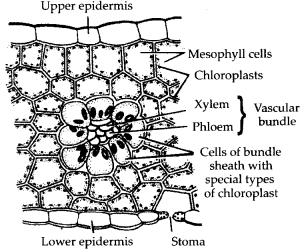A possible purpose of photorespiration may be:
1.
assimilation of nitrate from the soil
2.
translocation of carbohydrates
3.
enhanced PGR efficiency
4.
differentiation of plant cells
The following diagram shows bundle sheath cells with “special” types of chloroplasts. What is special about them?

| 1. | They are larger than normal size |
| 2. | They are agranal |
| 3. | They are dimorphic |
| 4. | Calvin cycle cannot take place in them |
In chloroplasts, protons are actively pumped from
| 1. | the intermembrane space to the matrix. |
| 2. | the matrix to the stroma. |
| 3. | the stroma to the thylakoid space. |
| 4. | the thylakoid space to the intermembrane space. |
The following diagram shows the photosynthetic carbon cycle. A and B can respectively be:
| 1. | Pyruvate; malate or aspartate |
| 2. | Phoshoglycerate; fumarate or aspartate |
| 3. | Phosphoenol pyruvate; malate or aspartate |
| 4. | Phosphoenol pyruvate; fumarate or aspartate |
The relationship between photosynthesis and respiration can be best described as:
| 1. | Photosynthesis and respiration are reversal of each other in biochemical pathways. |
| 2. | Photosynthesis stores energy in complex organic molecules, while respiration releases it. |
| 3. | Respiration occurs only in animals and photosynthesis occurs only in plants. |
| 4. | Respiration results in formation of ATP but photosynthesis can only use them. |
Identify the incorrect statement regarding the enzyme PEP carboxylase:
| 1. | PEP carboxylase has a lower Km for bicarbonate ions, hence, higher affinity — than RuBisCO. |
| 2. | O2 is a very poor substrate for this enzyme. |
| 3. | It plays an important role in C4 cycle but not in CAM plants. |
| 4. | PEP carboxylase is also significant in non-photosynthetic metabolic pathways. |
What can occur during both photosynthesis and respiration?
I: The reduction of oxygen that forms water.
II: Formation of ATP by chemiosmosis
| 1. | Only I | 2. | Only II |
| 3. | Both I and II | 4. | None |
Carbon dioxide splits to form oxygen during:
1. photosynthesis.
2. respiration.
3. photorespiration.
4.None.
Identify the correct statements regarding factors affecting photosynthesis:
| I: | At very high light intensities chlorophyll damage can occur due to photo-oxidation. |
| II: | Affinity for carbon dioxide of the enzyme RuBisCO is reduced at higher temperatures. |
| III: | The current availability of carbon dioxide may be a limiting factor for C3 plants. |
| IV: | If leaf undergoes senescence, loss of chlorophyll occurs. |
| 1. | I, II and III only | 2. | I, II and IV only |
| 3. | II, II and IV only | 4. | I, II, III and IV |
Probably the strongest biological oxidizing agent is P680+ because:
| 1. | It accepts electron in both photosystems. |
| 2. | It transfers electrons to plastoquinone. |
| 3. | It strongly attracts electrons formed by the splitting of water. |
| 4. | It transfers electrons to plastocyanin. |








